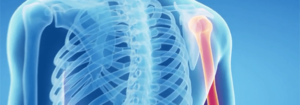 A common shoulder injury for athletes is shoulder instability or a shoulder dislocation. Depending upon the severity, this injury can be a simple fix or involve surgery.
A common shoulder injury for athletes is shoulder instability or a shoulder dislocation. Depending upon the severity, this injury can be a simple fix or involve surgery.
What is a Shoulder Dislocation?
A shoulder dislocation occurs when the head of the humerus (upper arm bone) pops out of the shallow shoulder socket of the scapula (called the glenoid). This can happen when a strong force pulls the shoulder upward or outward, or from an extreme external rotation of the humerus.
Dislocation can be full or partial:
Partial dislocation (also called subluxation) is where the head of the humerus slips out of the socket momentarily and then snaps back into place.
Full dislocation involves the head of the humerus coming completely out of the socket.
“Shoulder injuries are frequent in contact sports like football,” said Orthopaedic Surgeon Jeffrey Klauser. “When the ball in the shoulder socket dislocates, it can cause damage to the soft tissue that surrounds the socket – called the labrum – which helps keep that ball and socket together. And when that’s torn, unfortunately, that can lead to recurrent dislocations down the line.”
Symptoms of a shoulder dislocation include pain (often severe), instability and weakness in the shoulder area, inability to move the shoulder, swelling, bruising, shoulder contour appears abnormal, and numbness and tingling around the shoulder or in the arm or fingers.
Treatment Options
The doctor will move the head of the humerus back into the shoulder joint socket by applying traction to the arm. Patients will wear a sling or a device called a shoulder immobilizer to keep the shoulder from moving initially to help with pain and improve stability. Surgery is often needed for a shoulder that dislocates repeatedly or if there is a tear in the labrum.
“Treatment options for a labrum tear in the shoulder vary depending on the severity and the athlete and the sport he or she plays,” Dr. Klauser said. “We can prescribe physical therapy to strengthen the rotator cuff muscles in the shoulder and help keep that ball and socket solid and stable. If the patient’s injuries are more severe and require surgery, we can surgically repair the tissue to get them back to a full functioning shoulder.”
Recovery
Both treatment options require several months of rehabilitation and recovery, but fortunately, the chances for a full recovery are excellent.
“It takes several months of physical therapy to get patients back to full range and strength,” Dr. Klauser said. “In about four to five months, we can get athletes back to playing sports at an elite level.”
To see more of what Griffin Health can offer you, visit Sports Medicine Center.